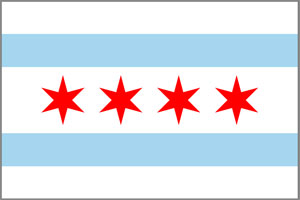 The answer is no, but Roman Mars at 99% Invisible can explain why Chicago’s is the best. Judging by the the North American Vexillological Society’s five principles of flag design, Wallace Rice, who designed Chicago’s flag in 1917, had a preternatural talent for inspiring civic pride. He would be pleased to know that today the Chicago flag adorns every municipal building, bicyclist’s messenger bag, and tattooed hipster bicep in Chicago. Here’s why it works:
The answer is no, but Roman Mars at 99% Invisible can explain why Chicago’s is the best. Judging by the the North American Vexillological Society’s five principles of flag design, Wallace Rice, who designed Chicago’s flag in 1917, had a preternatural talent for inspiring civic pride. He would be pleased to know that today the Chicago flag adorns every municipal building, bicyclist’s messenger bag, and tattooed hipster bicep in Chicago. Here’s why it works:
1. The flag should be so simple a child can draw it from memory.
Four stars and two blue bars. It doesn’t get much simpler than that.
2. Use meaningful symbolism
Many Chicagoans could probably tell you that the four stars stand for significant moments in Chicago’s history. Fewer will recall what the blue bars stand for, but it should be as obvious as Lake Michigan is big and the Chicago River is smelly: the blue bars stand for the city’s two defining bodies of water.
3. Use 2-3 basic colors
Red and blue on a white background. Simplicity this elegant is often imitated, but never duplicated.
4. Never use writing or seals
As Roman Mars notes, if you have to spell out what the flag means, then what’s the point of having one anyway?
5. Be distinctive or be related
The Chicago flag obviously evokes the US flag, but is entirely its own creation. It’s a powerful reminder that with imagination, common elements like stars and stripes can be reconfigured in a powerful new way. In fact, it’s the Chicago flag that drapes the coffins of the city’s fallen police and firefighters, and not the American flag. This alone speaks to the sense of attachment that Chicagoans feel toward their flag.
As Mars explains, these design principles make a difference: compare Chicago’s flag to San Francisco’s, for instance. New York City’s isn’t nearly as bad, but still violates Rule #4, and looks suspiciously French-ish to me. I think you’ll agree we really dodged a bullet when Rice’s design was approved almost 100 years ago.
